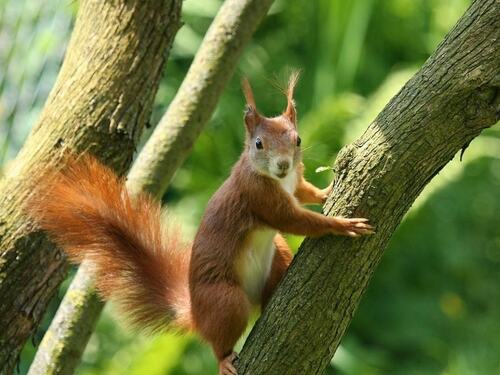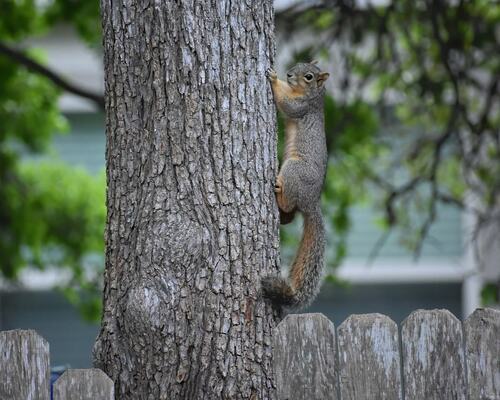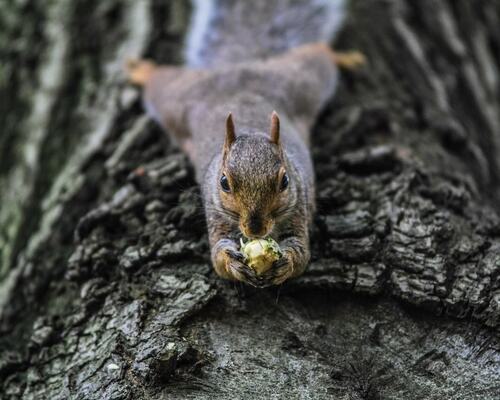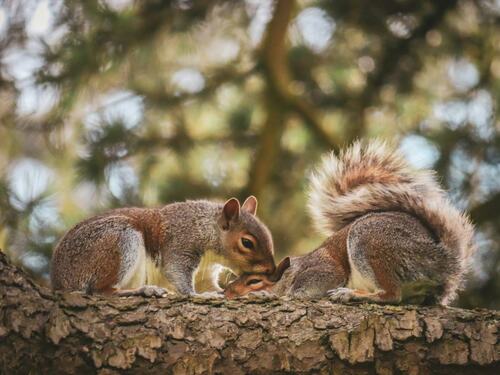The Hidden Wonders of Urban Squirrels: How Trees Create Their Bustling Habitats
Introduction
When you think of urban wildlife , squirrels are likely one of the first creatures that come to mind. These bushy-tailed acrobats are a ubiquitous sight, scurrying across power lines and darting between tree branches. But have you ever wondered what lies beneath the surface of these charismatic city dwellers? As it turns out, the secret to the success of urban squirrels lies in the very trees that dot our streets and parks. In this captivating exploration, we’ll dive into the hidden world of squirrels and uncover how trees create the bustling habitats that allow these clever critters to thrive in the concrete jungle. Get ready to see your neighborhood squirrels in a whole new light!
The Essential Role of Trees in Urban Squirrel Habitats

A Red Squirrel on a Tree Branch – Image by Andreas Hoja from Pixabay
Trees are the beating heart of urban squirrel habitats, offering these clever creatures a veritable feast of resources. From providing abundant food sources like nuts, seeds, and buds to creating safe nesting sites in tree cavities and branches, the urban forest is squirrels’ primary lifeline. Not only do trees offer vital shelter from predators and harsh weather; they also facilitate the squirrels’ agile movements and navigation through the city.
Just imagine the bustling activity within a mature oak tree’s canopy—squirrels scampering along the branches, pausing to nibble on the abundant acorns, all while keeping a watchful eye out for potential threats. Or picture the ingenious way these furry friends use the interconnected treetops as a high-speed highway, leaping from one maple to the next as they forage and explore their territory. The intricate relationship between squirrels and their arboreal homes is truly a marvel to behold.
Of course, the benefits of urban trees go beyond just supporting squirrel populations. These green giants also play a crucial role in mitigating the urban heat island effect, improving air quality, and managing stormwater runoff —all of which contribute to a healthier, more livable city for both wildlife and human residents. By fostering thriving urban tree canopies, we’re not only creating ideal habitats for our furry friends but also enhancing the overall sustainability and resilience of our communities.
Squirrel-Friendly Tree Species for Urban Environments
When it comes to supporting thriving urban squirrel populations, not all trees are created equally. Certain species stand out for their ability to provide the essential resources these clever critters need to survive and thrive in the city. At the top of the list are mighty oak trees, a squirrel’s favorite thanks to their abundant and nutritious acorns. Maples, with their protein-rich seeds, are another squirrel-approved option, while pine trees offer year-round shelter and food sources. And let’s not forget the delectable nuts of hickory trees or the seasonal bounty of fruit trees—irresistible treats that squirrels eagerly await every year.
By incorporating a diverse array of these squirrel-friendly tree species into our urban landscapes, we can create verdant oases that cater to the unique needs of our furry neighbors. Imagine a city where towering oaks, graceful maples, and stately pines work in harmony to support a thriving squirrel population—a true urban wildlife haven! And the benefits of these tree-dwelling squirrels extend far beyond just providing entertainment for residents. As these clever critters scamper and forage, they play a vital role in dispersing tree seeds, helping to regenerate and diversify the urban forest.
Building an Urban Squirrel Haven: Tree Planting and Maintenance

An Urban Squirrel on a Backyard Tree – Image by Ray Shrewsberry from Pixabay
Of course, establishing these squirrel-friendly urban forests doesn’t happen by chance. It requires intentional planning, careful tree selection, and diligent maintenance. When it comes to planting new trees, it’s crucial to choose species that are well suited to the local climate and soil conditions, ensuring their long-term vigor and survival. And once those trees are in the ground, regular pruning and care are essential to maintain the features that make them so appealing to our furry friends—from preserving tree cavities for nesting to promoting the growth of nut-bearing branches.
But the benefits of this effort go far beyond just supporting squirrels. By creating a diverse, multilayered urban tree canopy, we’re also enhancing the overall health and biodiversity of the city’s ecosystem. Squirrels, after all, play a vital role in dispersing tree seeds and supporting reforestation efforts. It’s a true symbiotic relationship where the trees provide the resources, and the squirrels help ensure the continued growth and regeneration of the urban forest.
Navigating Potential Conflicts Between Squirrels and Trees
Of course, the relationship between squirrels and their arboreal homes isn’t always a perfectly harmonious one. These clever critters can sometimes cause damage to trees , gnawing on bark or stripping away delicate buds and branches. And in some cases, the sheer abundance of squirrels in an urban area can pose challenges for tree health and longevity.
But with a proactive, balanced approach, we can find ways to manage these potential conflicts and maintain a thriving, mutually beneficial relationship between squirrels and their urban tree habitats. Strategies like selective pruning , the use of tree guards, and even the strategic placement of supplemental food sources can help mitigate any issues that arise. And by promoting a diverse, resilient urban forest, we can ensure that there are ample resources to support both squirrel populations and healthy tree growth.
The Cascading Benefits of Squirrel-Friendly Urban Forests

A Squirrel Enjoys a Nut While Resting on a Tree Trunk – Image by Pexels from Pixabay
Beyond just providing homes and sustenance for our furry friends, the incorporation of squirrel-friendly trees into urban landscapes brings a wealth of additional benefits to cities and their residents. These thriving urban forests not only enhance biodiversity and ecological resilience but also offer important ecosystem services that improve quality of life.
For example, the shade and cooling effects of a mature, multilayered tree canopy can help mitigate the urban heat island effect, lowering energy costs and making cities more comfortable and livable, especially during hot summer months. The air-purifying abilities of urban trees also contribute to healthier breathing environments, while their stormwater management capabilities help reduce the risk of flooding. And let’s not forget the mental health and well-being boosts that come from simply watching the playful antics of squirrels scampering through the branches—a much-needed respite from the hustle and bustle of city life.
Case Studies: Innovative Urban Forestry for Squirrels
Around the world, innovative urban forestry programs are leading the charge in creating thriving habitats for city-dwelling squirrels. In Chicago, for example, the “Tree Squirrel Conservation Initiative” has not only enhanced the urban tree canopy but also provided critical resources and nesting sites to support the region’s diverse squirrel populations. And in Melbourne, Australia, the “Urban Squirrel Sanctuary” project has transformed underutilized green spaces into vibrant, squirrel-friendly oases, complete with a variety of tree species that cater to these clever critters’ needs.
These inspiring case studies demonstrate that by thoughtfully incorporating squirrel-friendly trees and management practices into our cities, we can cultivate urban ecosystems that benefit both wildlife and human residents. And the lessons learned from these pioneering programs can be adapted and replicated in communities around the globe, empowering everyone to do their part in creating squirrel-friendly cities.
Beyond Squirrels: The Broader Impacts of Urban Forestry

Two Squirrels Bonding on a Branch – Photo by Boys in Bristol Photography on Unsplash
While our focus has been on the critical role of trees in supporting urban squirrel populations, it’s important to recognize that the benefits of thoughtful urban forestry extend far beyond just helping these charismatic rodents. By creating diverse, resilient urban tree canopies, we’re also enhancing the habitats and resources available to a wide range of other wildlife species, from birds and pollinators to small mammals and invertebrates.
These thriving urban ecosystems don’t just benefit the animals, either. The presence of healthy, mature trees in cities has been shown to have a profoundly positive impact on human well-being , from improved mental health and reduced stress levels to increased physical activity and property values. And as we continue to grapple with the challenges of climate change, the carbon sequestration and stormwater management capabilities of urban forests become increasingly crucial for building resilient, sustainable communities.
Conclusion
As we’ve discovered, the secret to the success of urban squirrels lies in the very trees that shape our cityscapes. These furry friends rely on the bounty and shelter provided by a diverse, healthy urban forest in order to thrive in the concrete jungle. By understanding the intimate relationship between squirrels and their arboreal havens, we can work together to create vibrant, squirrel-friendly cities that benefit both wildlife and human residents.
Remember, every tree you plant is an investment in the future of urban squirrels and the broader ecosystem. Whether you’re a city planner, a homeowner, or simply a nature lover, you have the power to make a difference. So, let’s get planting and give these charismatic acrobats the homes they deserve! By cultivating squirrel-friendly urban forests, we can ensure that the pitter-patter of tiny paws and the chatter of busy tails remain a cherished part of our city landscapes for generations to come.
Contact Arborist Now for expert assistance with choosing, planting, and maintaining wildlife-friendly trees in the San Francisco Bay Area.


